Freedom of movement

It’s early summer morning. I’m 15 years old. I and my mum are standing in a long crowded queue outside of the embassy of Finland in Moscow. The consulate reception is not opened yet, but the queue is already impressive. Tourists, businessmen, travel agents. Our case is somewhat different - a couple of months ago I was picked as an exchange student to be sent to a foreign country, together with another dude from our college. We’re not from Moscow. We’re from Cherepovets - a small town the size of Helsinki, famous for the density of local factories and purple clouds around the industrial area.
Cherepovets is considered the largest town in the region, and in my first 15 years of life I never been to Moscow. Up to that point, Cherepovets was my biggest town, cultural centre and the place to be. The general path of a career in Cherepovets consisted of finishing the school, getting into a professional school, maybe local university, doing a summer internship at one of the factories, and eventually working for the next 40 years there. Your freedom was largely represented by the variety of factories. You were free to pick from a chemical factory, matchstick factory, ship factory, dairy product factory. Despite that, you would likely and inevitably end up working for a metallurgical conglomerate, one of the largest in the country. In fact, the college I ended up after the school also belonged to that corporation and was in practice an incubator for the skilled people going straight to metal production.
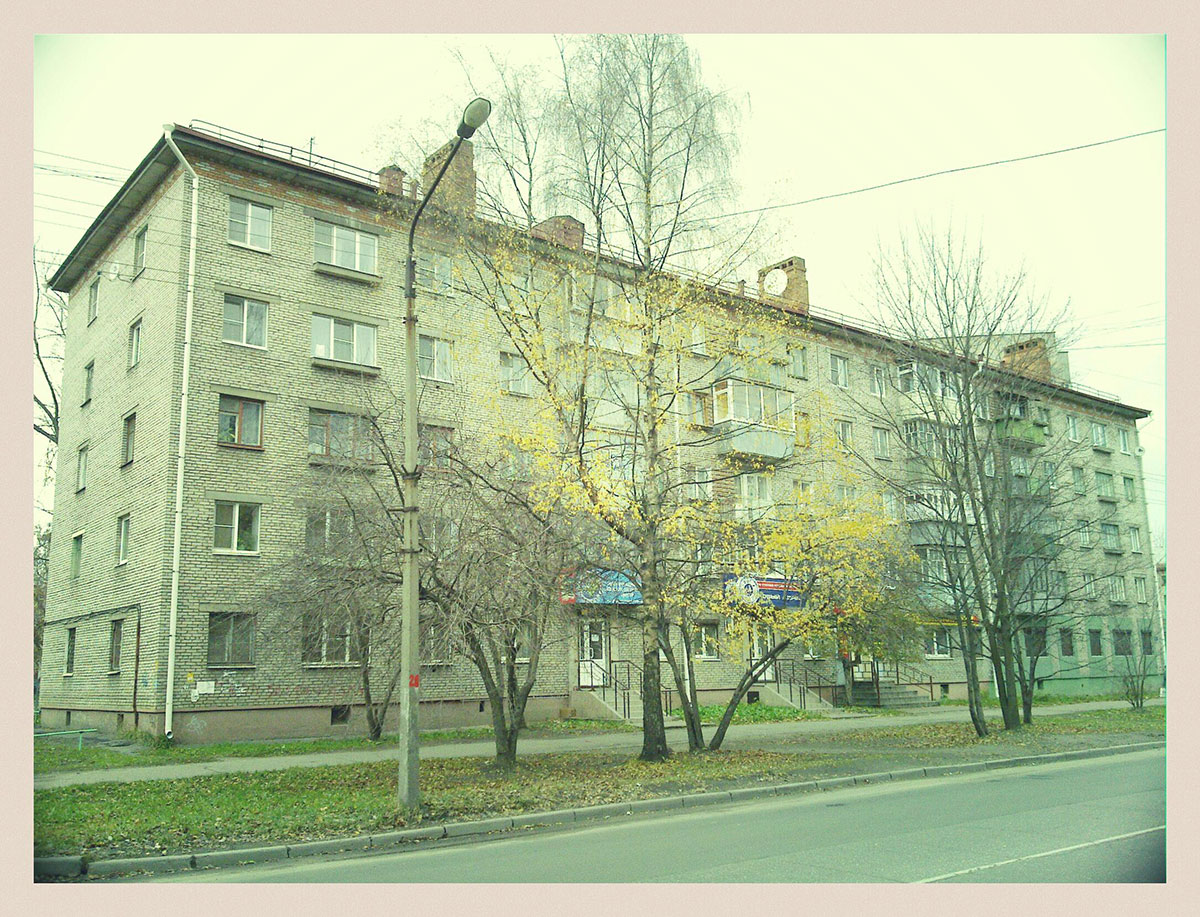
There was a student exchange program however with a small town in Finland. Most of the towns in Finland are small. This one was especially tiny, with around 20k people, far up north, next to the gulf of Bothnia. What made is special is that also had a metal production plant, a professional school and a university.
Let’s recapture for a second. I’m a 15 years old dude from Cherepovets. I need to get to Finland. How hard can this be?
Passport
Normally you’d get your passport at the age of 16. You can apply earlier, but you’d need a special reasoning for that. I think it took me about few weeks to get that done.
Passport for travelling
In Soviet Russia, no one needed to travel abroad, since everything was perfect in the place of your residence. If you did need to travel, that would require you a bunch of paperwork, recommendations from you place of work or study, release papers from the army, background checks by the KGB and lots of questioning. This has changed slightly after the USSR was gone, and a new era was begun. Slightly, but not hugely. You would still need to apply for a special passport that would have your name written in latin letters, and be valid for foreign visas.
And of course, you would need to have your “main” passport done first.
It took an impressive pile of paperwork and about a month (I think) to get the travel passport done.
Visa
Because I needed a student visa valid for a year, I had to travel personally to the consulate of Finland in Moscow. I should mention that if you’re a lucky resident of Saint-Petersburg, you would also find a local consulate in your town. Everyone else had to travel to Moscow. I mean, I was lucky to live in the European part of the country, just a train day away.
It also wasn’t really well organised at the consulate. No appointments, a live queue outside of the fence, then getting through the security inside of the consulate and queueing to the bulletproof reception windows. Most of us were also hastily filling up the long forms and glueing profile photos. Another impressive pile of papers, forms for myself and the second dude who was also picked to be exchanged. Finally, we’re told to wait for a month, call and check on the status. After the decision is done you’d have to come down again (just a day on a train away) and pick up the passports.
We got visas 2 months later and an extra slice of bureaucracy from Finnish consulate - one of the papers was missing and they delayed the answer for an extra month, up to the point when we already needed to go.
All in all, 4 months of paperwork, and you were good to go.
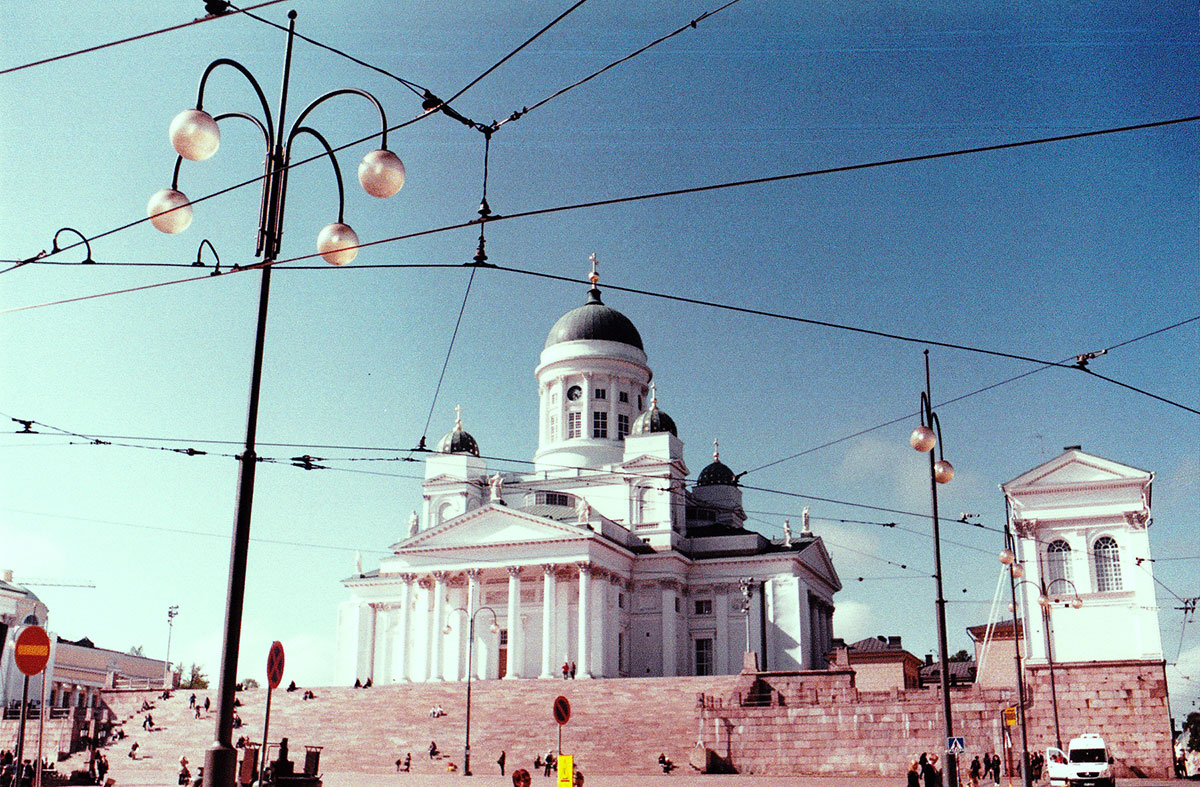
Sometimes I feel like people don’t appreciate the freedom of movement. This is largely concentrated around people who have always had it. It’s one of those things that feel essential while you have it, but you are shocked once it is taken away.
As far as I know, freedom of movement implemented in the EU is unique and only experience, that no other union or country has done. At least not on the same scale. Can you consider the United States as a bunch of different countries? A bit, maybe. But culture wise Europe is an amazingly diverse package, bundled with a million of different languages, foods and traditions. Yet somehow there’s an agreement to let everyone (within the Union) travel and work freely, anywhere you want.
With zero paperwork.
I remember my first time crossing the border of Finland and Sweden. We were driving in a car. It was forest, then more forest, then a bridge across the river. And a sign saying “Welcome to Sweden”. No delays, no paperwork, no one guarding the border with a barbed wire. I was shocked.
At this point, you want to be a part of this amazing thing. You want to be part of the EU, contribute, and make it even better. You make it the purpose of your life. Because this is one of the most amazing things humanity has ever achieved. Instead of fighting each other - give everyone freedom to live anywhere you want, to be anything you want. Free medicine, free education, social support for everyone in the union, doesn’t matter which language you’re speaking. That’s something that inspires you.
This is humanity at its best.
A very special cookie
First few countries you visit while living in Finland are most likely to be Sweden, Norway and Estonia. This is when you learn that Norway is not in the EU, but somehow the border between Finland and Norway looks exactly the same, as between Sweden and Finland. No one is guarding it, and if you miss the “Welcome to Norway” sign, you might later notice that speed limits have changed, as did colours of the road signs. This is when you start learning about the special status of the Norway. In addition to the EU, there is the Schengen agreement. You might not be an EU citizen, just a tourist (or a student) - but you’re still going to enjoy a good portion of the same freedom of movement as the EU citizens do. Yes, you will not be able to work in another country, but you will be able to freely visit almost all of them. And more - as in the case of Norway, which is not even a part of the EU.
As you progress in your travels and reach the farthest reaches, you are likely to encounter an ancient island of Britain. This will be another eye-opening discovery - despite the UK being part of the EU, they will not let you in with a Finnish visa. The reason being that the UK was never a part of the Schengen agreement, hence you have to apply for another visa. The UK visa. Unless you are a proper EU citizen, in which case you can freely come and go as you please.
My first visit to the UK was in 2009. I’ve filled 36 pages long form - this achievement still holds my personal record for being the longest form I’ve ever filled in my life. Paid 90 euros of processing fees. Arranged an appointment at the UK consulate in Helsinki. Gave up my fingerprints and retina scan. All of this only to find out that they are unable to process my request. The reason being that I was planning to travel in April, while my Finnish visa was expiring in May. According to The Rules, a visa from the origin country must be valid for at least 2 months after my visit to the UK is concluded. I guess the UK was secretly afraid I’d illegally stay on the island.

Now let’s combine the bureaucracy of one country with the bureaucracy of another.
The Finnish visa that was about to expire was, in fact, 3 years long visa. After that, I could apply for a permanent residentship (doesn’t equal citizenship, completely different topic). However, because I had to renew it before full 3 years of that visa would expire, I couldn’t apply for the permanent visa just yet. At that point, Finland gave me 4 years long visa, and I could finally apply for a UK tourist visa.
I’m sorry for the amount of the details, but I really want you to feel the absurdity of the whole system.
The problem is, it doesn’t feel absurd at all, as long as you don’t think about it. This is the way we’ve arranged our travels for a past couple of hundreds of years (we all know that before that you’d simply gallop into another country on a horse while swinging your sword).
London was a nice place in 2009, but somewhat unattractive in terms of interesting software related jobs. And back at home Nokia was still dominating the world - although some signs of the decay were coming through. The most talented software people in Finland would likely be employed by Nokia at a time, and then maybe poached by one of the Silicon Valley -based companies. Fast forward 5 years and everything has changed. Nokia is no more, and London somehow managed to turn things around and became one of the most attractive places to work in the software industry. I also got my EU citizenship and could finally exercise proper 100% pure freedom of movement. You would think that the story ends here with a nice happy ending. That’s a big fat nope.
While I was living in Finland I got married to a girl from Russia. She got Finnish residentship (6 months of processing and 150 euros in fees). Then we moved to the UK. She got the UK residentship (6 months of processing with both her and my passports taken by the Home Office). Unlike Finnish residentship, UK residentship sucks at freedom of movement - it is simply not appreciated anywhere beyond the UK borders. Not even in the Commonwealth Countries (a term you learn after moving here). UK residentship allows you to stay in the UK, and that’s about it. If you’d like to travel to the EU, you have to apply for a visa.
I did quite a bit of research on this topic. Technically there is an EU law that allows family members of the EU citizen to travel without a visa. However, people tend to agree that explaining this to a Ryanair employee might not get you on a flight. So, let’s be honest, the law doesn’t work and you need a visa.
Things get more interesting at this point. You can apply for a normal tourist visa (~£60 fee), or a family member visa (£0 fee). You will still have to fill in a lengthy form of a country you want to visit, attach profile pictures (£10), proof of address (free, but you have to order it at least 2 weeks in advance) and marriage certificate (phone call to Finnish magistrate, 27 euros of fees and 2 weeks of delivery). Family member visa only allows you to travel together with your “more entitled” family member. Same-sex partners are ok. If you want to travel alone, you would still have to apply for a normal tourist visa.
Once again you’ve probably noticed how quickly things became complicated. Let’s for a moment compare this to a scenario when you have a residence of a Schengen area country. You want to visit another EU country - you jump on a flight and go.
Zero paperwork.
My wife could eventually get a UK citizenship (7 years of residence, £1200 in fees), and we could both enjoy a freedom of movement. However, Brexit happened. The UK is aiming at the Norway special cookie case. Considering that the UK already was a special cookie within the EU, that makes them a very special cookie. However, it’s not going to be exactly a Norway case, since Norway is a part of Schengen area. Freedom of movement is something the UK residents wants to limit by all cost. This obviously cuts both ways, but sometimes you have to get what you really want. From the freedom of movement perspective, UK citizenship gets massively devalued. You’ll get to stay in the UK, but is it something you really, really want? Home Office is inflating immigration fees and tightening rules, Brexit campaigners want immigration to stop completely and get all the foreigners out. And let’s be honest, the best way to do that is to ruin the country and make it complete unattractive on a global scale.
After living in a few countries you start to view the world from a different perspective. It’s a hugely diverse world, but it should be open for everyone. Freedom of movement should be universal. It is likely not to happen on a global scale anytime soon. But somehow the EU made it work on a significant part of the planet. This is an incredibly huge achievement.
Implementing freedom of movement is considered hard and is opposed by many people. But it transcends us as a humanity. This is when you start thinking about the planet as a whole, and not just about your personal lawn. And we are having global problems on our hands - like the ever heating planet that might as well destroy all of us tomorrow, despite the residence statuses or saving accounts. Should we maybe grow up a bit, develop a sense of empathy and maybe just a tiny bit of tolerance for each other?
And, eventually, cancel all the paperwork.
Agfa Flexilette twin reflex 35mm camera

TLR means twin lens reflex. Unlike SLR:s, TLR features 2 lenses and a mirror. Most TLR cameras are made for medium format film. 35mm film TLR:s are a rare breed, Agfa Flexilette being one of those.
Flexilette itself is a rare find. It’s been manufactured in 1960-61, succeeded by Agfa Optima Reflex camera. Agfa struggled to compete with the growing range of SLR cameras and gave up after producing these 2 models. Today Flexilette represents a unique camera with an unusual design, waist-level viewfinder, twin lenses, durable mechanics, and it is guaranteed to draw at least some attention in today’s world full of technology.
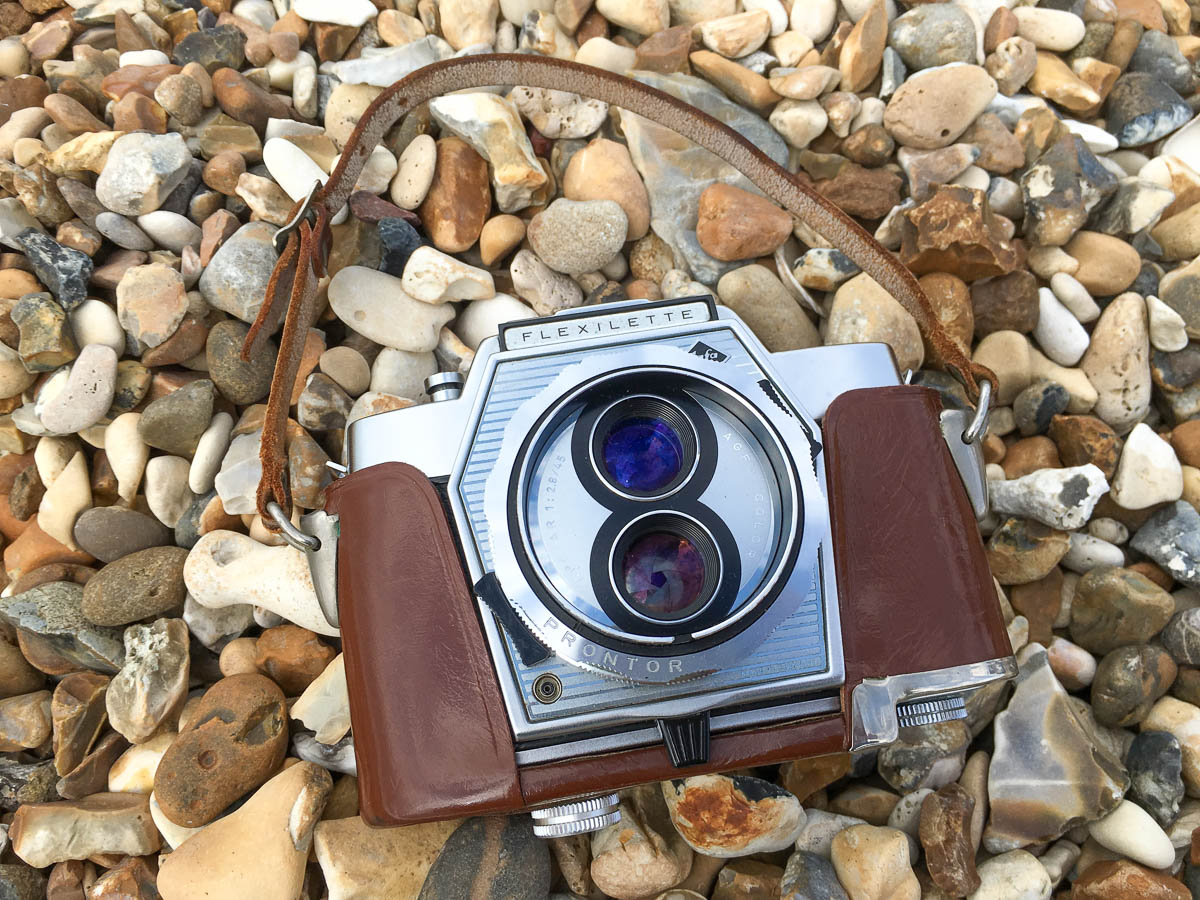
We got Flexilette during one of the recent camera fairs in Westminster. In perfectly working condition, with original case. Since then I’ve been using it as an everyday 35mm film camera, compact enough to always fit into my backpack. It is not the lightest camera, most of the body is made of metal after all. But it feels very good in hands, with no sharp edges, nice and rounded body and easy to press buttons.
Now that you are the proud owner of an Agfa Flexilette twin-lens reflex camera you will be able to take wonderful photographs as a constant reminder of the past. You are to be congratulated on your choice. — Official manual.
A word of warning if you are reading this on mobile connection - this post contains lots of pictures.
GOV UX Proof of address
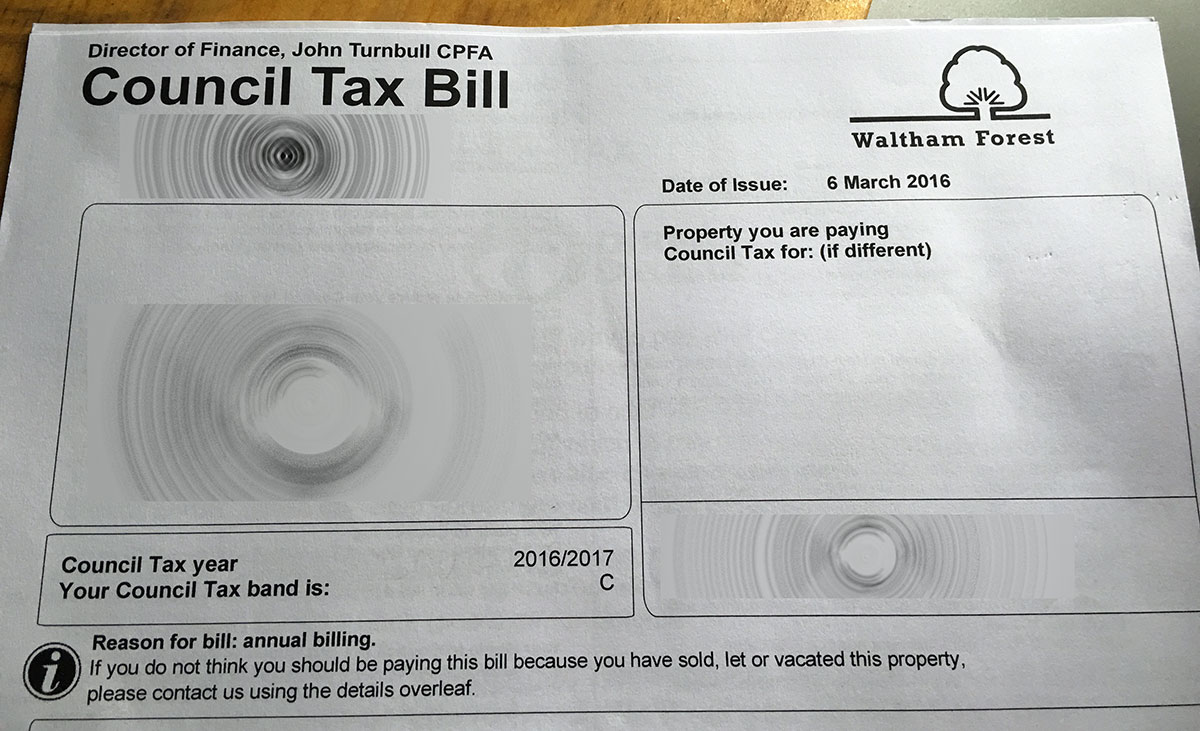
One of the basic needs when dealing with governmental services for a person is to prove your current place of residency. It may sound trivial, but there are multiple approaches to solving this problem.
In the UK it is called “proof of address”. It is always required when you want to:
- Open a bank account
- Register with a local surgery
- Change your address details with a bank
- Apply for a travel visa
What is it? To prove that you are indeed residing at a given address you must provide a council tax or utility bill, with your name on it, delivered at a given address. There is a catch - it should be issued within 30 days or it is not valid anymore.
As everything in Britain, this rule was probably a brilliant invention in its simplicity at some point of history. Today, not so much.
Your local council will mail you tax bill about once a year. Utility bills will be issued at various intervals. However, all my current utility bills are electronic. I pay for electricity and gas directly from a mobile app. This leaves council tax bill as the main source of being one and only available proof of address.
In practice, you can make a telephone call and order new council tax bill at any moment. They will generally mail it within next couple of weeks. After that, you have a valid proof of address for the next 30 days. Problem postponed.
In Finland, they have a state register with data on everyone residing in the country (as well as citizens living abroad). This register contains your current address, marital status, national security number, and probably a bunch of other stuff. The register is used by the post office to verify delivery address. The same register is used by pretty much every other government agency when they need to verify your residency.
When dealing with Finnish banks, the local version of NHS or any other government agency it is generally enough to tell your national identity number. They will check it on the state register and will verify everything else from there. This comes super handy during phone calls - all you need to tell is your private state ID - which is much easier than spelling out your name, address and phone number.
Handling things with the Finnish Register Office is also not ideal today. Access to the main database is limited to the clerks only, and the database itself is also not very fast from what I can tell. My dream scenario would be some sort of open repository where I can issue key and authorise 3rd parties to access certain parts of my personal data registered with the state. This repository should be international. For example, today marriage should be registered separately in each state of your residence - and in the case of divorce - unregistered separately.
To be fair, this year Finnish Register Office started offering online services - quite a limited subsection of them. They are going to extend the list of online services during this and next years.
Brexit, or let's be more human
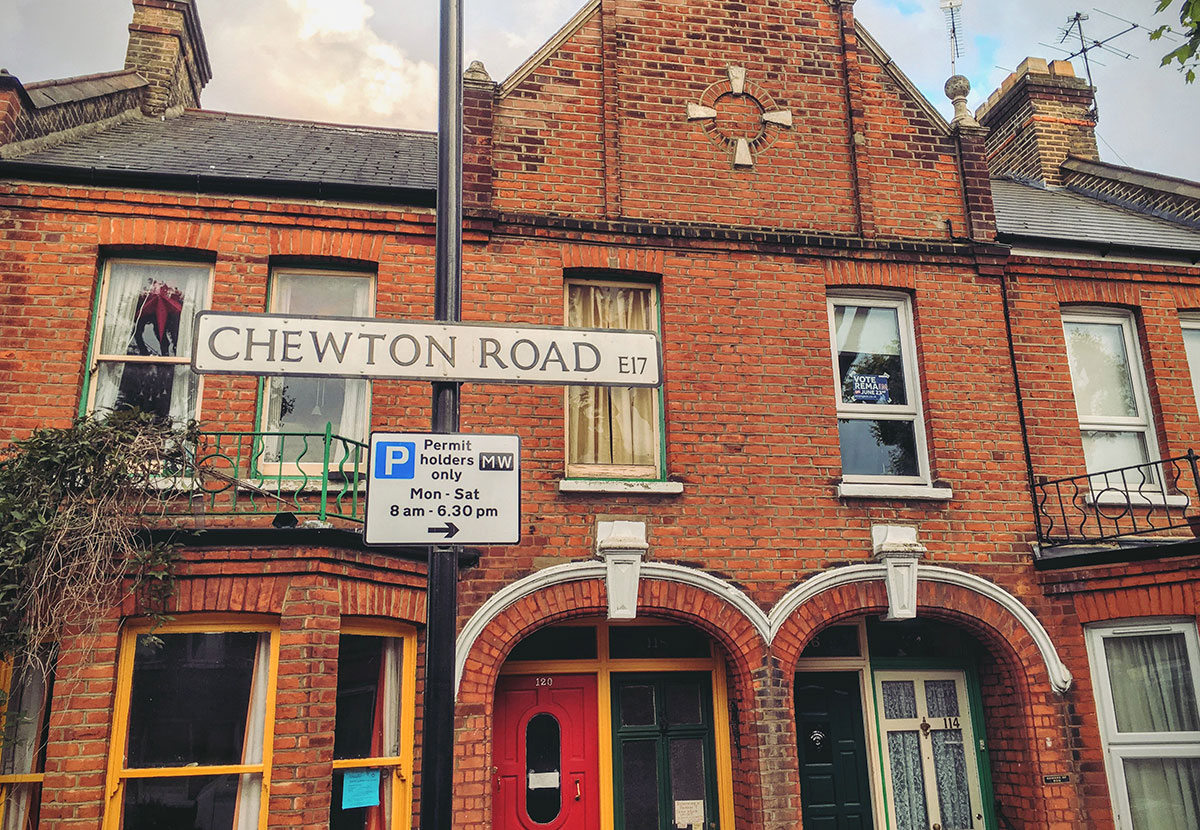
There are so many words written on the topic of Brexit that I was going to just ignore the issue and move on.
Especially since I have no vote on the matter.
However, I live in the UK now. I pay taxes. And I genuinely love this place. Well, mostly London. But also rest of the country, the bits I've seen.
The reason I live here is my Finnish passport. I was born in Russia, but then moved to Finland when I was 15. Thanks to free education in Finland I got my degree, found a job, and did quite well for the next 15 years.
Then, thanks to the freedom of movement, I decided to try another country. It is pretty awesome when you can find a job anywhere within EU, move there and start working, with no need for a working permit or any other bureaucratical nonsense. Freedom of movement is one of the essential things in the world, strangely restricted in some parts. If you’re a less lucky citizen of a non-EU country, generally you would have to either stick with that country or spend lots of efforts trying to achieve the same level of movement freedom.
UK has always been a bit of a special fruit of EU. My first visit to London was in 2009 when I only had my Russian passport. Application for a UK visa was 36 pages long (not kidding), cost me around 90 euros and an extra day to travel to the UK consulate in Helsinki. Today they don’t even have a consulate in Helsinki - the closest one is in Stockholm, and you'd have to send your passport there, along with the biometric data. Despite all of that, I remembered that feeling of a huge but cosy megapolis where I could settle for a few years some day.
It’s been 2.5 years now since I and my wife relocated from Finland. If we talk strictly about British things, it’ll be separate cold and hot water taps, electric shower, full English breakfast, jacket potato - although who am I kidding, I love jacket potatoes here. Fish and chips are less relevant since both of us are vegetarians. But London makes up to you with a diversity of cultures brought by immigrants like myself. Most amazing Turkish baklava, Greek coffee, Sichuan food, falafels. I’m talking food now, but actually, to me, London is a place of acceptance. It is the only place in the world where you can come with your accent, and people will say - “Hey, nice of you to come, what would you want to do?”. No one cares about your accent or being a foreigner here. Even if you're a talking bear, it will not make you special here. What matters is who you actually are, what do you actually want. It’s a place of endless possibilities with the most amazing people around.
Again most of the people you’ll meet will be from somewhere else. Either from different parts of Britain or more than often from other countries.
London is a place of tolerance. It is not a funny idea you entertain in your mind, read about it in books or watch in movies. You are surrounded by a thousand of different cultures, every time you step out of your house. Tolerance and empathy towards things different from your views and opinions - you just get it, like a level up, after living here for a while. There is literally no other place in the world like this. (Or maybe is, but I haven’t been there). In here you live in constant realisation how diverse people can be. And it’s a good thing. Diversity and tolerance teach openness toward others.
In my idealistic version of the world, everyone can freely travel, settle anywhere, and do stuff they want. People are friendly and we help each other. Also maybe a universal basic income for everyone, in case you just don’t feel like doing anything today. Oh, also free food, free unlimited energy, robots building stuff for us. Some parts of this dream are already here, although not evenly distributed. EU managed to provide freedom of moving and settling around a significant chunk of countries. You’ll get free health care, social benefits (if eligible), education and language courses. For me, the idea of helping each other and uniting everyone into something bigger just feels right. Breaking this is the opposite of right.
It is highly tempting to compare running a country to running a commercial company. There is, however, a fundamental difference. Countries cannot be run for profit. The main purpose of any country is to provide the best possible environment for its residents. Not pile up money. Not lock down its borders and pretend that there is no one else around. Denial was sort of possible one hundred years ago when communication was largely non-existent, travel was hard and was performed mainly when going to war. Today you can follow up climate change via live HD broadcast from space. This is our planet, it’s the only one we have, no one is getting out of here anytime soon. Denial is a sweet thing, but to me is a sign of ignorance.
Running a country like a commercial company has largely messed up our priorities. Somehow we put monetary gains above humanitarian values. This is happening in the age when we all know that money is highly superficial. We have invented it, it is not backed by gold anymore, it is largely made of overvalued mortgages. Yes, we stick to the idea that money is the most important thing - but mainly because we used to this. In my mind money is very much secondary, and today with all the technological advancements we should be able to provide everyone with free food, shelter and stuff. Honestly, today we have enough stuff for everyone. For the first couple of years while living in London we got all sort of stuff from streets, left by people who couldn’t fit it in the (tiny) apartments.
London is an amazing place, but it wasn’t like this for always. I think it became highly attractive in the past 5-ish years. Suddenly there are small creative companies changing the historical ways of doing things. This is where you want to be - change the world, play a part of improving it. The only way forward really is to completely dissolve borders, welcome talented people from all around the world, with their cultures and ways of thinking. This is certainly an idealistic view, and surely there will be people who just want refuge. This is again where EU steps in, and a coalition of countries can figure out a way of evenly distributing challenges.
Change is good. And we should be able to handle it. It wouldn’t be a problem for me and my wife to move to another country. Let’s be 100% honest - the UK is not on top of the family friendly country list. Today I’d say it’ll be Sweden or Finland. Or even Estonia with their electronic government and a way to pay taxes in 5 mins, online. Full data transparency, a personal chip with a private key for every citizen. Ability to vote online, while enjoying a drink in your country house. I could work remotely too. But there is something here in London that makes me wake up every day, commute for an hour into the city. This something is people - some of the most talented people in the world. Together we are making it better. As one of the founders put it, our tiny company employs people from 20 nationalities around the world. We’re all immigrants here. And all of us will have no problem to move somewhere else, job wise. The world is a big place.
But I’d prefer to stay here. London is one amazing place. After a recent move, we’ve found a bunch of Eastern European food shops selling pretty authentic food straight from my Soviet childhood. In many ways London is like Lego - it gives you an enormous amount of bricks, and you can build out of it any life you want.
And I love building.
Update: there is an ongoing discussion on Reddit for separating London from the UK and keeping it as part of EU.
Update 2: If you haven’t seen the #CatsAgainstBrexit, it will make your day.
Oculus CV1
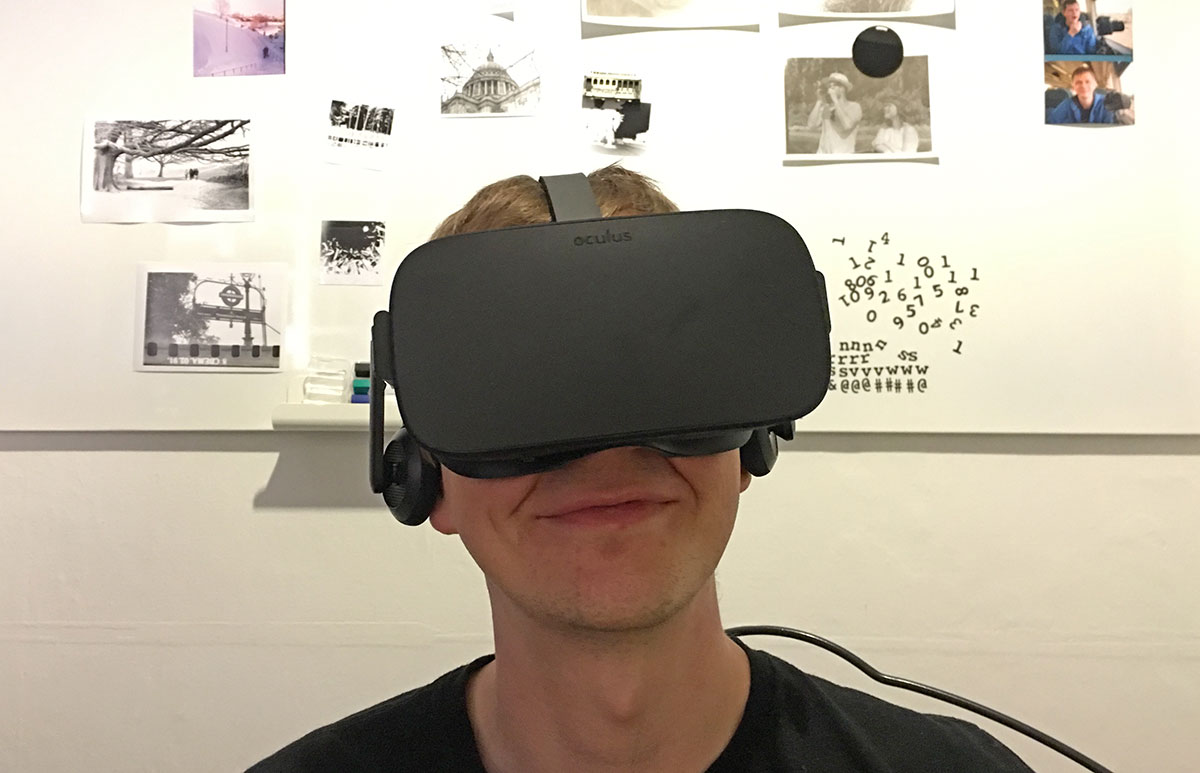
I’ve got my CV1 order now about 2 months ago and been playing with it semi-actively. It’s a solid piece of experience, it works, and there is good selection of content.
Ordering
In January Oculus did that famous announcement of a pre-order date for a consumer version. They had a countdown on a site. I think it was around 4pm in the UK when it stroke 0:00, and the whole Oculus site went down. Multiple Cmd-R presses, some cursing, and parallel chatting to a friend who also wanted to place his order. Finally, we got through. This was the moment when the price of the headset was revealed for the very first time. There was a moment of hesitation, and then I ordered. A friend hesitated for 5 more minutes and ordered too. Delivery date was set to the late March. The grand total price with UK VAT and delivery fee was around £550.
I think in March Oculus announced that the delivery will be delayed. In the end of March, they waived the delivery fee, and new grand total price became about £500. That was a nice gesture I thought. My delivery date was pushed to the end of May. It was beginning of April, and we were about to embark on a trip to Amsterdam. I also suddenly remembered that since the pre-order we moved house and I should probably update the delivery address.
While in Amsterdam I’m getting notification from Oculus that “good news, we’re about to deliver your order, and going to charge you any moment now”. Next day they charged me and dispatched a note that headset will be delivered in the next couple of days. Next thing I know there’s notification from UPS with tracking number.
You can actually postpone or even redirect delivery of a parcel on the UPS site. Alas to do so you have to register and confirm your address by receiving a mail with a secret code in it. So no, I could not postpone or cancel the delivery before they would try and deliver it first.
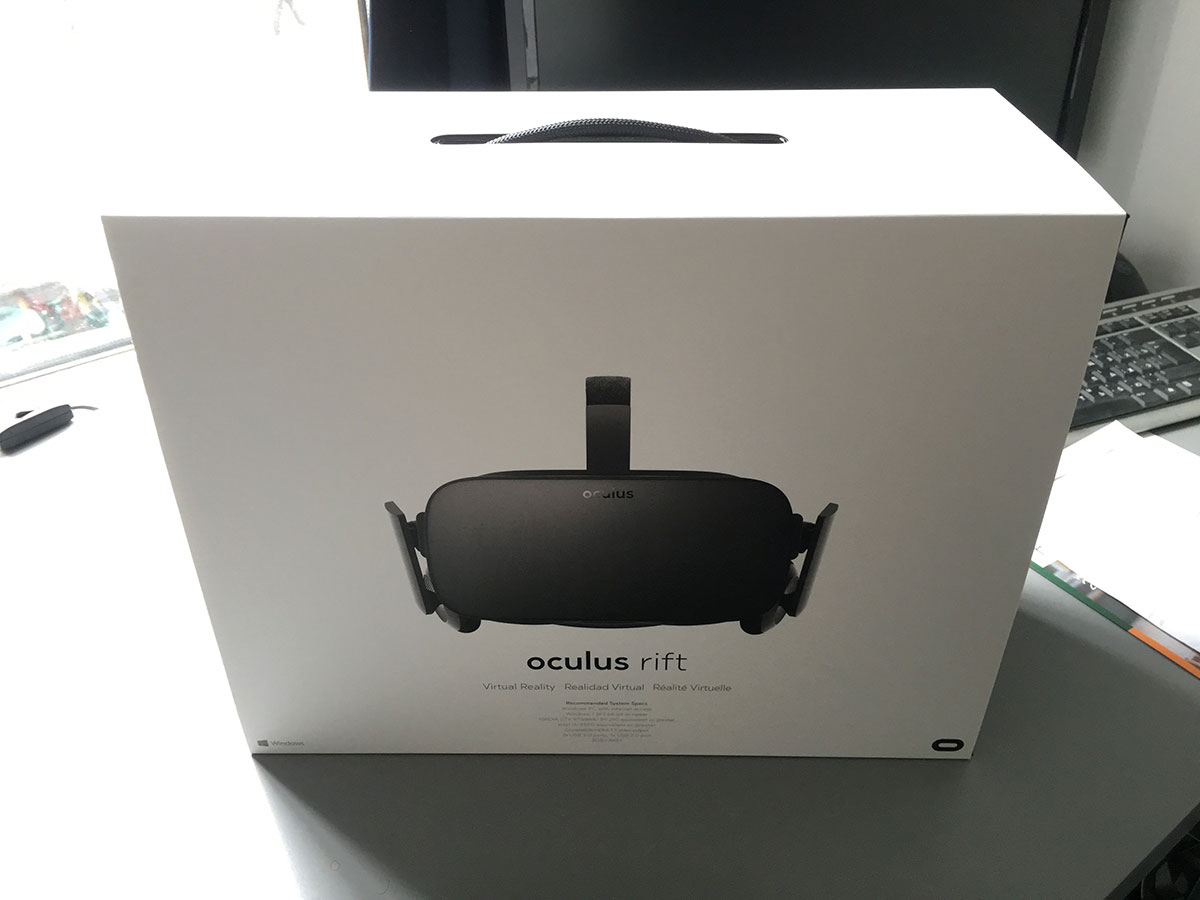
One more day later I get notified that UPS tried to deliver, nobody was home, and - phew - they didn’t leave the package with neighbours or in the bushes, but brought it back to the UPS pick up point, where it was waiting for me.
Upgrading PC
My PC is from 2010. It is pretty decent. Back at a time, it scored the fastest consumer grade graphics card on the market, astonishing 12Gb of RAM and Intel i7 quad core CPU. I vividly remember buying it so I could finally play Fallout 3. Last November we got Fallout 4 out, and it refused to launch.
The reason being that Nvidia GTX 295 graphics card is not cool anymore. “Not a problem,” I thought and upgraded it to GTX 980. Nvidia site also listed GTX 970 as a bare minimum for VR. Fallout 4 launcher tested new system and set all settings to ultra quality. Gaming never looked better on that PC.
I’ve also upgraded the main hard drive to SSD and added extra USB 3 ports. The only thing that Oculus currently complains about is CPU. Recommended CPU is Intel i5-6400. However, CPU is probably the only part on a PC that is almost impossible to upgrade. You’d have to change motherboard then, and at this point, you might as well buy a new PC with components tested and fit together. For now, I’m sticking with my Intel i7. Especially since it doesn’t seem to matter now, with GTX 980 taking most of the load.
Unboxing and setup
There aren’t many parts in the Oculus box. In addition to the headset, you’ll get the tracking sensor, Xbox controller and an Oculus remote - basically a simplified controller. Tracking sensor is expected to be placed on the table in front of yourself. There’s guided installation from Oculus that will get you all setup. For me it just worked, cables got connected and devices got recognised. The biggest trouble was getting Xbox controller paired with the USB stick. After that, you put the headset on, and the magic begins.
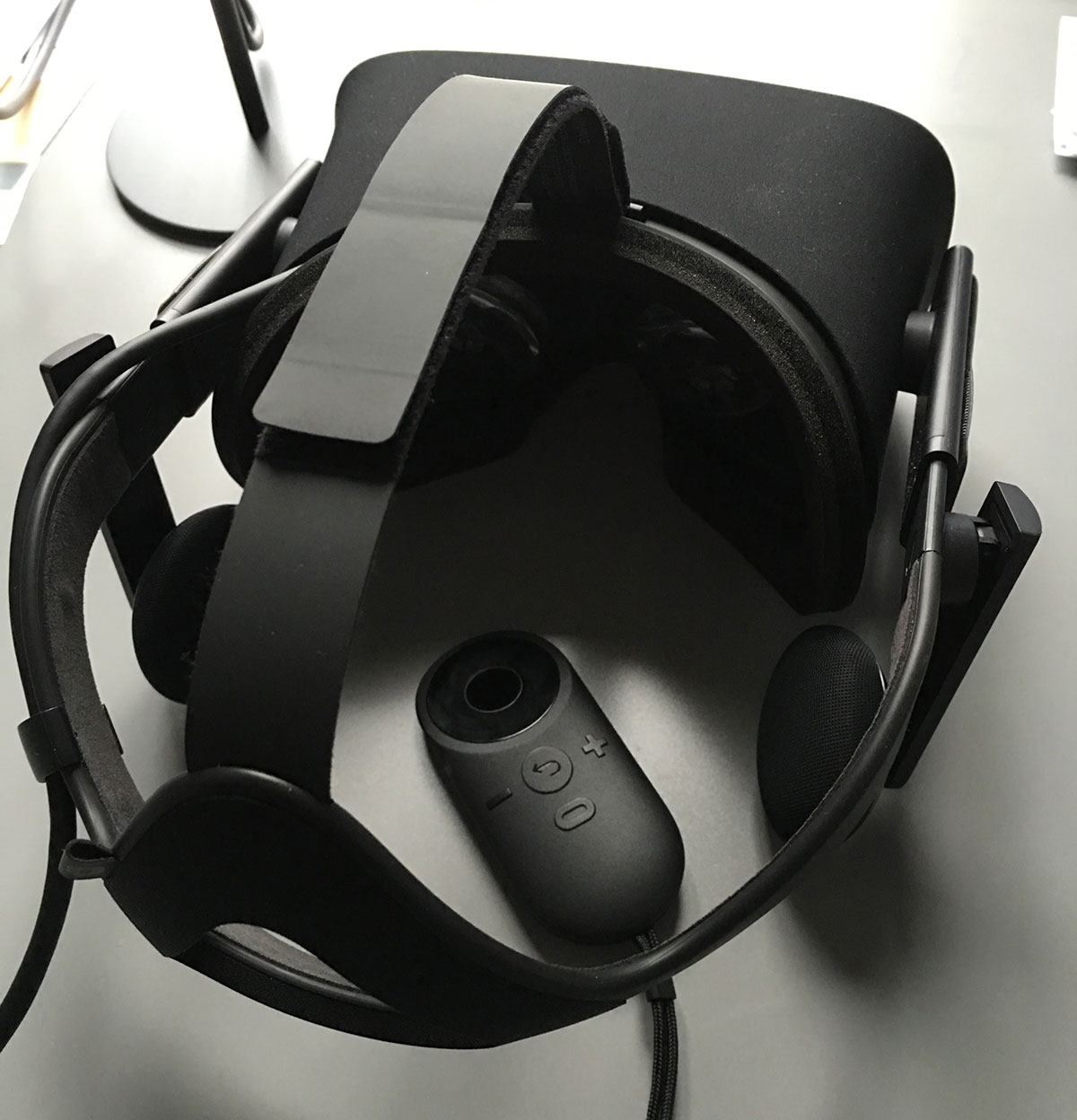
Oculus Home is a Steam-like piece of software that you get out of the box. There you can browse your library, buy stuff, download, and potentially chat with friends (I still have none). It is slowly evolving, they are bringing new features into it. Oculus Home is a proper VR app where you can remain and do stuff, and switch from one experience to another while fully immersed in VR. There is also a desktop version, much less amazing.
Oculus Home will be the primary entry point for getting and consuming content. They are also bringing Oculus exclusives that are only available there, and only for Oculus. Eve Valkyrie is one example, Chronos is another. I was generally amazed how you can switch between apps comfortably, without a need to get the headset off. Before with DK1 and DK2 you would download an experience, try to launch it, and with some degree of success, you’d get it working on a screen and only then you’d put a headset on. With CV1 headset is no longer a secondary or mirrored screen. It is a separate device. This also means that some of the older DK2 experiences are no longer functioning properly with CV1.
Content
Oculus Home and Steam are the two places where you can get content for Oculus VR.
Oculus Home is something you’ll get out of the box, and will be somewhat ushered to use as a primary store. There’s nothing wrong with that. You can buy games, software, and potentially films in the future. You also get a good deal of free content, some of which will be bundled with your headset. Drivers for both headset and Oculus controller will be updated via Oculus Home. It will also provide access to early concepts and demos, most of which you can get for free.
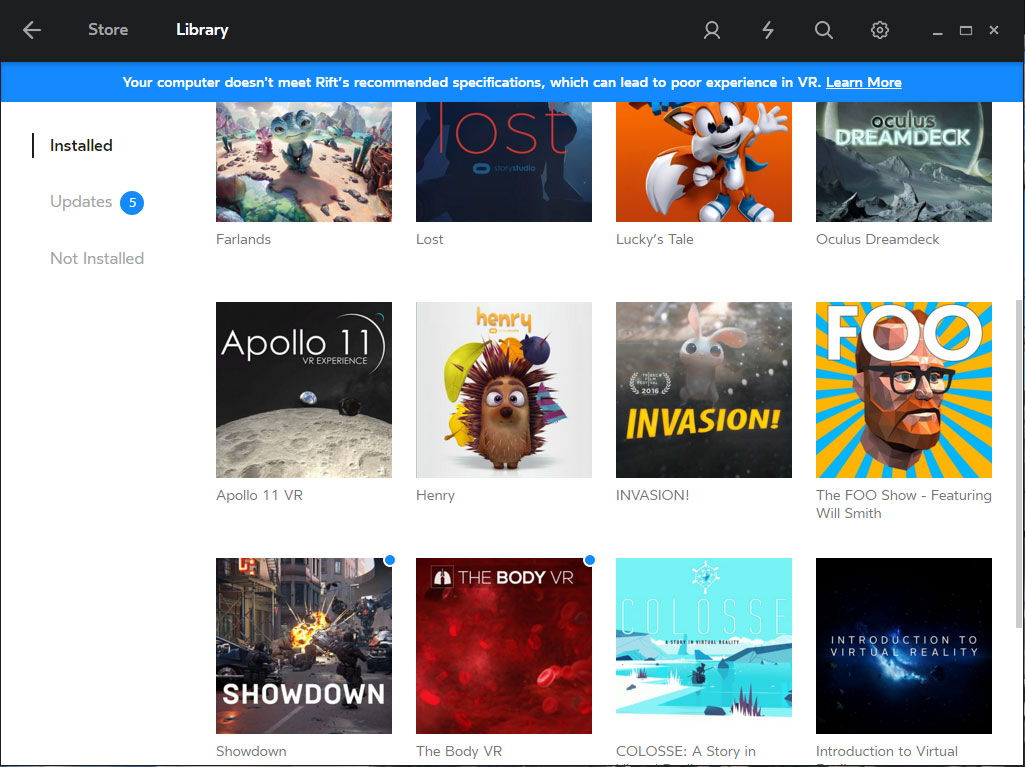
My only problem with Oculus Home at the moment is prices. Most of the exclusive games currently cost around £40 with no discounts in sight.
This is where Steam comes in.
Steam is a clunky ancient piece of software that is good at one thing - discounts. Another thing that Steam can do well is refunds. If you buy a game, play it for a few minutes, and decide it is not fun - you can apply for a refund and within one day you most likely to get it. Refunds are somewhat critical when we talk about VR content. You see, with VR it is very personal. What is fine for one person will make another person feel sick. An action is no longer happening on a remote screen while you are controlling it from a distance. You are immersed into it. And you want to feel good while being in there.
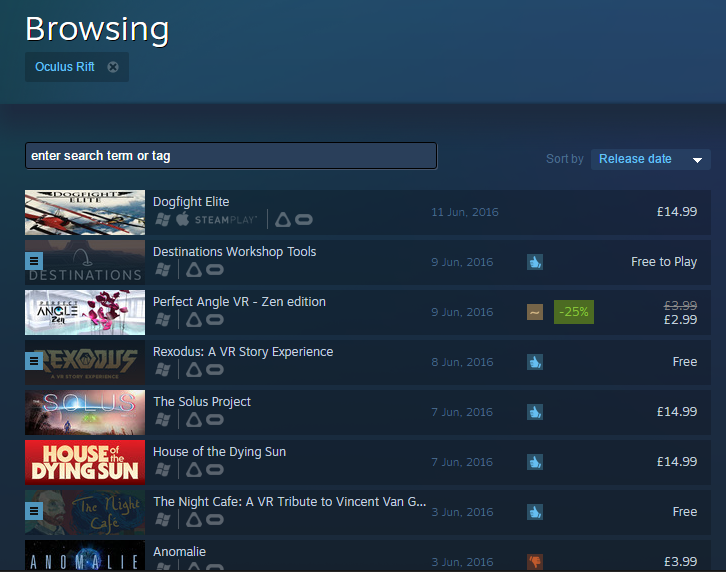
Not many studios get VR UX today. Some do it better than others. In many cases, it is hit or miss. Hence refunds. It is super fun to try lots of things from the catalogue, as long as you can return the product back on a shelf and get your money. This is not the case with Oculus Home, and some people are furious about this.
Another killer feature that has absolutely no relation to VR in Steam is the ability to pay with bitcoins.
You can easily filter VR games in Steam. An important part is to remove HTC Vive tag and leave only Oculus compatible games. There are lots of incredibly awesome content for Vive, but all of it requires trackable controllers. Things will hopefully change towards the end of this year when Oculus releases Touch controllers.
There is also the ongoing debate about DRM locking content to a certain kind of headset, with Oculus, I believe being the bad guys today. This might play out in a way that Vive users will never get Eve Valkyrie or Chronos, and it might swing the other way too by Valve locking Vive exclusives. Let’s hope this will be resolved in a friendly and calm manner.
Feeling sick
It truly depends on a content.
Most games you’ll find in Oculus Home seems to be fine. It’s important to get the headset fit comfortably on your head. There is a certain sweet spot when the image is the sharpest and you almost don’t feel the pressure. Interocular distance is also important. Spend some time, adjust all the adjustables. After that putting headset on is incredibly easy and fast.
So it’s down to the content. There are multiple issues that can cause uncomfortable feelings. They can be put there inadvertently or deliberately. In both cases, you’ll want to stop and get out.
I’ll try and categorise.
Head spinning. Can be caused by movements in the simulation of nature not anticipated by the brain. Our brain is pretty good at anticipating things and can incur actual physical feelings when all goes according to the plan. On the other hand, say, when you turn your head left but the picture turns right, the brain goes completely mental. This is also accompanied by the most bizarre physical sensations.
Horror. Heavily amplified in VR, can be caused by quite non-threatening things when observed on the screen. It is also generally accompanied by feeling of helplessness since you don’t even have trackable motion controllers.
Disgust. Again, can be caused by relatively harmless things that are heavily amplified by the feeling of presence.
Sickness. I’ve had it only once, and it was in a flight simulator where the camera was attached directly to the plane. You could look around, but once the plane was spinning there were absolutely zero inertia involved - which you would normally have if you’d be flying inside the plane and had you head. Turned out inertia is a very important part of a comfortable VR flying experience.
Selected bits
From what I played so far, here are some of the best experiences.
Windlands.
A very simple looking game where you jump from one flying island to another. Somehow those guys got everything right. Feeling of propelling yourself through the air is incredible. Put a fan on the table for increased wow effect.
Keep Talking and Nobody Explodes.
You’ll need at least one another friend to play this one. It is also absolutely perfect for VR. You are the one immersed into a room with a ticking bomb nobody else can see. Your friends got instructions on how to disarm it. Go.
Radial G: Racing Evolved
Super fast futuristic racing game with techno music. This is how I’d imagine games in 2016 would be.
Crystal Rift
Grid based dungeon crawler with a VR twist. You get a glowing sword in your hand. Wait, there is no hand, just a glowing sword hovering on a side. You can strike skeletons with it. Also, find keys, unlock loot and on some occasions hop onto the miner rail trolley. There will be lava.
Apollo 11
This one is not strictly speaking a game. It’s a historical simulation of a legendary mission with a documentary audio track and a very dramatic music. It is also one incredible package.
I’ll just say one thing - when you are sitting in the command module, and the rocket is about to blast off - lean to the left and look out of the window. You can thank me for the hint and everyone at Oculus who invented trackable sensor.
Technolust
I’ve saved best for the last. Technolust is for the fans of Ready Player One and cyberpunk in general. It’s a sort of narrative with not so much shooting. Although, you will find yourself in the arcade full of games at some point. You’ll be able to jack into the classic arcades and experience all of them in VR.
There are some technical issues with Technolust on Steam. If you haven’t got it via Oculus Home, there is a life hack - launch the game via good old .exe file in /steamapps. It’ll work just fine then.
How bad are the lens flares?
They can be annoying at the beginning, but then you don’t generally notice them. However, this heavily depends on the position of the headset and sweet spot. Once the headset is adjusted, the issue is much less noticeable.
The issue here are fresnel lenses, and Oculus lenses apparently have smaller fragments, which liquidates chromatic aberrations, but introduces glares. Lenses are tricky business.
How about built-in headphones?
They are one of the best usability features of the Oculus. Thanks to those, now you can put the headset on and off with a single sweeping move. One device on a head with everything you need for immersion.
With both DK1 and DK2 there was alway that awkward dance when you put the headset on, then try to find headphones, then try to put those on too while figuring out the audio cable. There is a single cable now with CV1. It is long and feels durable.
Features for CV2
This is obviously a step towards something bigger. It is not the first step (which was DK1), but surely there is more to come.
For me, I’d say better lenses and retina grade resolution. Lenses for resolving glares issue. Better resolution for reading emails while in VR. You can do this now too, but you’d want to get an experience equivalent of having Macbook screen. Resolution is pretty decent today - for games, simulations and videos. I’d say it is not enough for precise work - whatever it might be.
Conclusions
CV1 is a solid consumer product. They also did a great job by implementing Oculus Home. Yes, it is maybe DRM locked and evil. But it’s homey. There are pillows. They might let us walk around sometimes in the future. Collect trophies in games and put them on shelves. Oh, I’d love that very much. Your personal home with inflatable extra rooms. That is something of a dream.
It is not perfect obviously, but it is a huge step towards accessible VR. Yes, you’ll need a powerful PC and Windows 10. This might change too - or they might actually come up with a backpack PC VR thingie.
Looking forward to it.